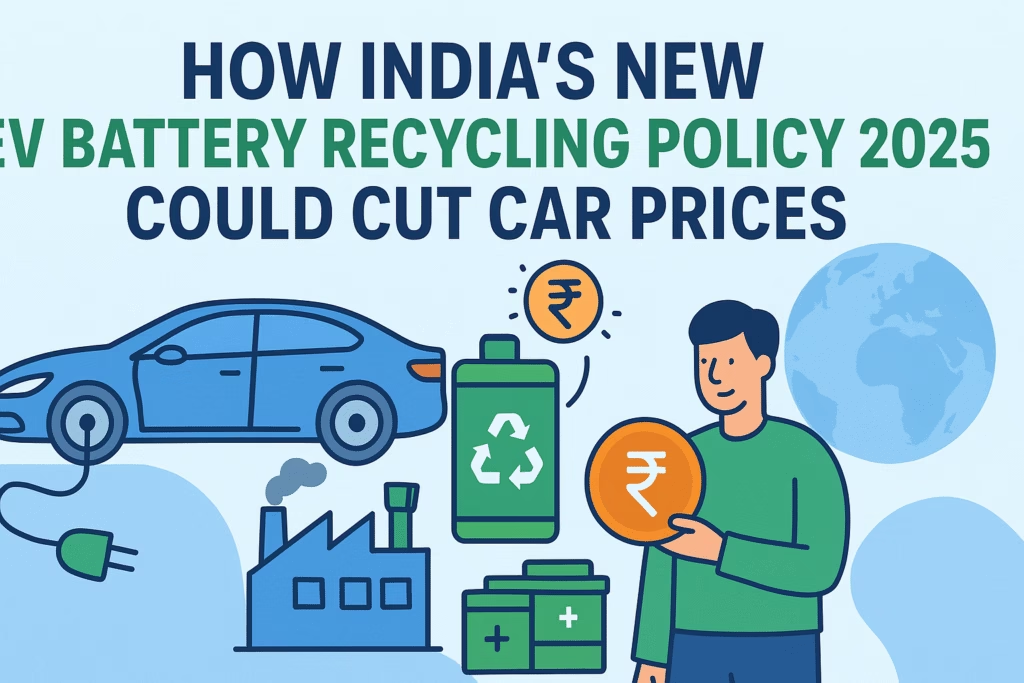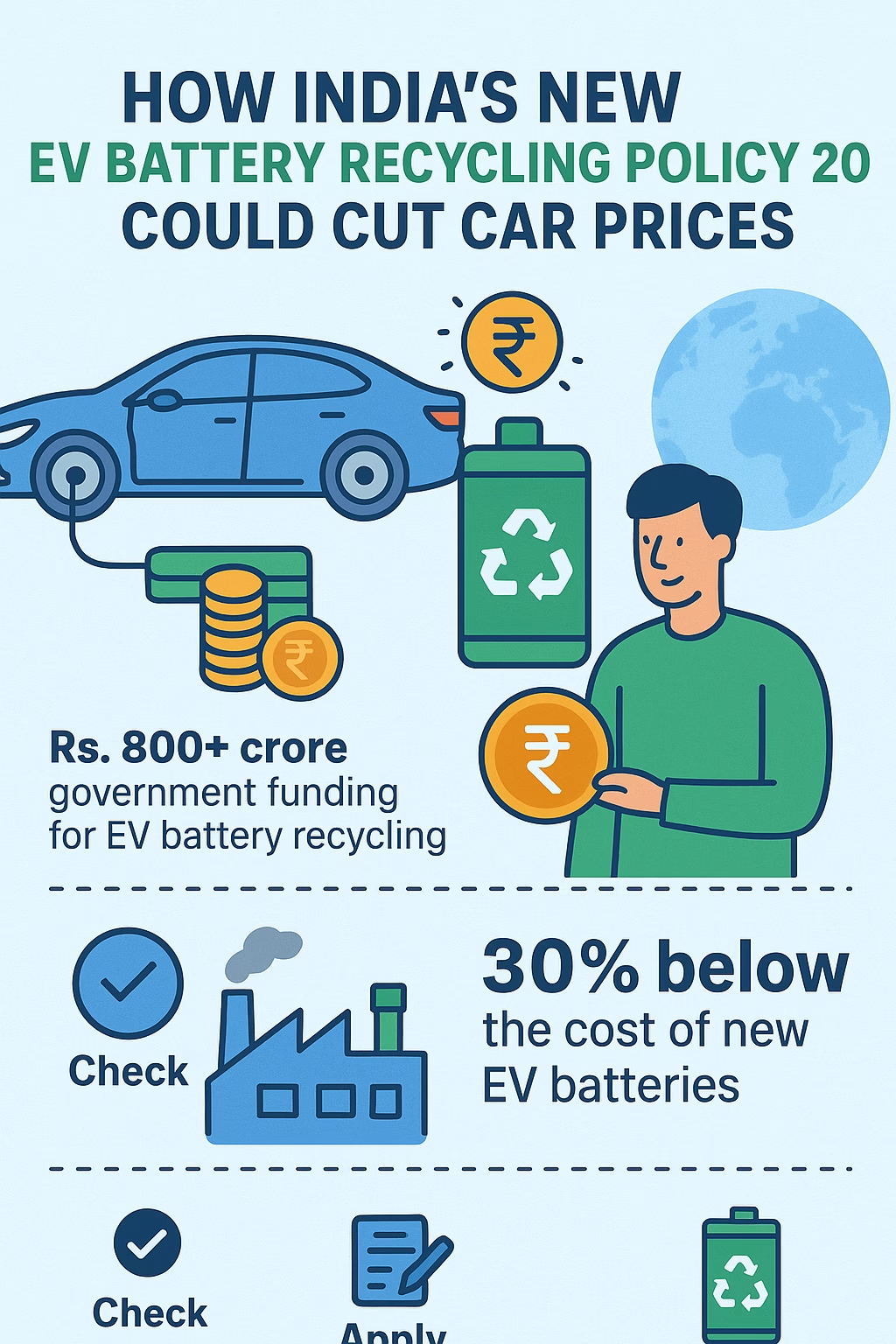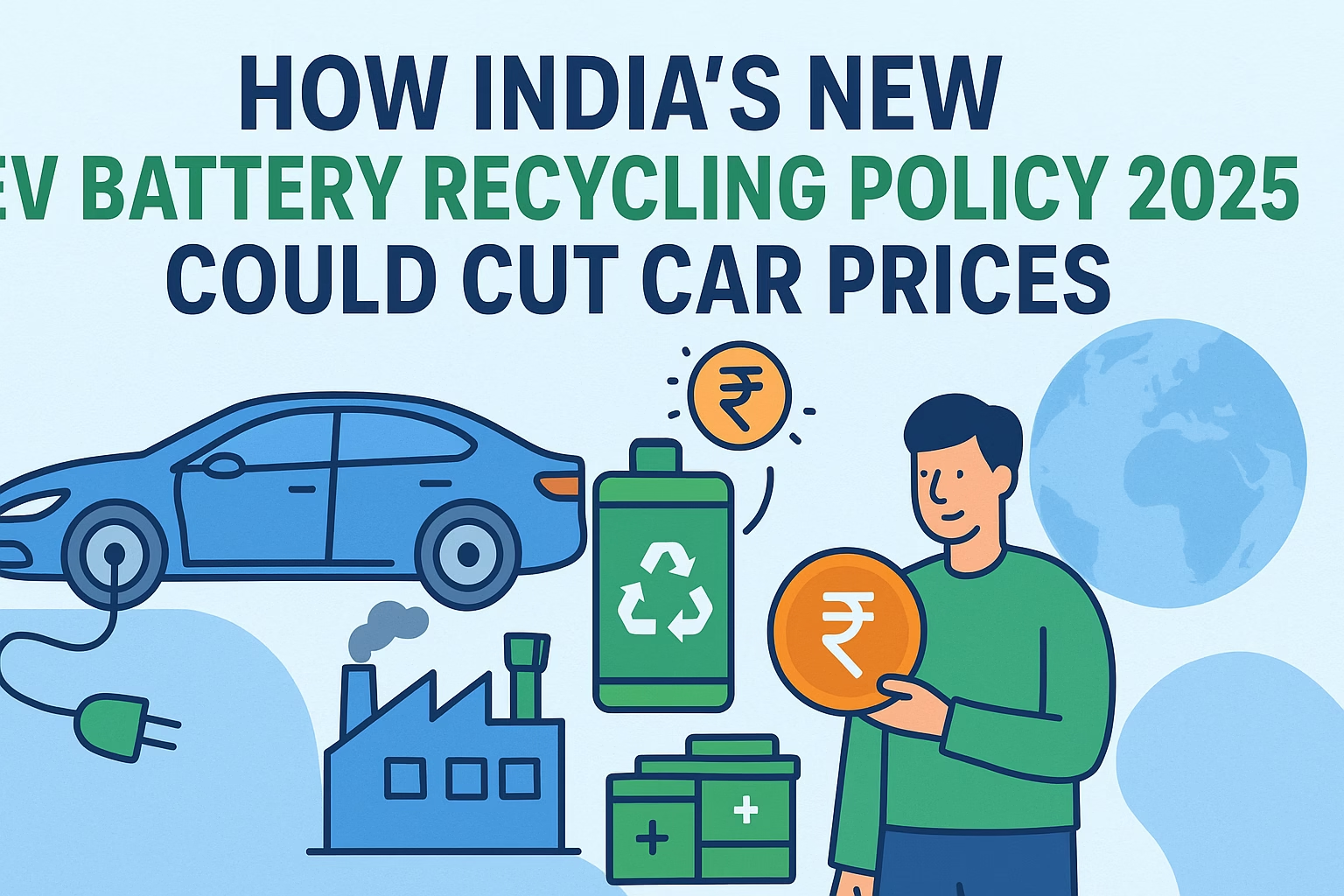Electric vehicles (EVs) are no longer a futuristic dream in India—they are becoming a part of everyday life. From Ola Electric scooters zooming on city roads to Tata Nexon EVs in middle-class households, the transition is happening faster than expected. Yet, one major hurdle has kept EV adoption from exploding: high prices, driven largely by expensive batteries.

Now, the government has stepped in with a bold move—India’s New EV Battery Recycling Policy in 2025. This landmark regulation is designed not only to make EVs more eco-friendly but also to cut car prices significantly for Indian buyers. Let’s break down what this policy means, how it works, and why it could change the game for small buyers and the EV industry as a whole.
Why Battery Recycling Matters for India
Batteries are the heart of an electric vehicle, but they come with challenges:
- Cost Factor: The battery makes up nearly 40% of an EV’s total cost. That means a ₹15 lakh EV has about ₹6 lakh worth of battery components.
- Import Dependency: India heavily depends on imported lithium, cobalt, and nickel, which makes pricing vulnerable to global supply fluctuations.
- Environmental Risk: Without recycling, millions of used EV batteries could end up in landfills, releasing toxic chemicals.
This is where India’s New EV Battery Recycling Policy in 2025 comes in. It directly addresses these issues by making recycling not just an option, but a mandate.
REALTED: How Battery Swapping Could Cut Your EV Charging Costs by 40% in 2025
Key Features of India’s New EV Battery Recycling Policy 2025
The government has designed this policy to ensure a circular economy for EV batteries. Some key provisions include:
- Extended Producer Responsibility (EPR):
Automakers are now responsible for collecting used batteries and ensuring proper recycling. - Mandatory Recycling Targets:
Manufacturers must recycle a certain percentage of their batteries each year, with targets increasing annually. - Incentives for Recycling Companies:
Startups and large firms involved in battery recycling will get tax benefits and subsidies. - Material Recovery Mandate:
The policy sets efficiency standards—companies must recover a minimum percentage of lithium, cobalt, and nickel.
By enforcing these points, India’s New EV Battery Recycling Policy in 2025 creates a foundation for cheaper, safer, and more sustainable EV production.
How the Policy Could Cut EV Car Prices
The big question most consumers have is: Will this policy actually make EVs cheaper? The answer is yes—and here’s how:
- Recovered Materials Lower Production Costs:
Recycled lithium and cobalt reduce the need for costly imports, cutting production costs for new batteries. - Stable Supply Chain = Stable Prices:
Domestic recycling creates a local supply chain, protecting Indian buyers from global price hikes. - Economies of Scale:
With more recycled material in circulation, the cost per unit battery drops, which means car prices fall too. - Projected Price Drop:
Analysts suggest India’s New EV Battery Recycling Policy in 2025 could lower EV prices by 10–15% within the next 2–3 years. For example, a Tata Nexon EV costing ₹15 lakh today could drop closer to ₹13 lakh.

Impact on Consumers & Small Buyers
The true winners of this policy are everyday Indians:
- Affordability in Tier-2 & Tier-3 Cities: Lower upfront costs will make EVs accessible beyond metro cities.
- Better Financing Options: As prices drop, banks and NBFCs will offer easier loan schemes, making EMIs more affordable.
- Consumer Confidence: Buyers hesitant about “battery replacement costs” will feel reassured knowing recycling reduces waste and long-term costs.
For a middle-class family planning to shift from petrol cars, India’s New EV Battery Recycling Policy in 2025 could be the turning point that makes EV ownership realistic.
FOLLOW TIME OF HINDUSTAN ON FACEBOOK
Boost for Indian EV Startups & Industry
It’s not just buyers who will benefit—this policy is also a huge boost for India’s EV industry.
- Startups in Recycling: Young companies working on advanced recycling technologies will see massive growth.
- Automakers’ Relief: Companies like Tata, Mahindra, and Ola Electric will reduce reliance on foreign suppliers.
- Job Creation: Recycling plants, supply chains, and collection networks will generate thousands of jobs across India.
By encouraging local players, India’s New EV Battery Recycling Policy in 2025 aligns perfectly with the “Make in India” and “Atmanirbhar Bharat” missions.
Comparison with Global Policies
India isn’t the first to focus on EV battery recycling. Globally, similar policies have proven successful:
- European Union (EU): The EU mandates a strict recycling quota, ensuring batteries are reused and materials are recovered efficiently.
- China: The world’s largest EV market enforces battery reuse and recycling with government-backed facilities.
- United States: The U.S. has invested heavily in recycling startups to reduce dependency on Chinese supply chains.
With India’s New EV Battery Recycling Policy in 2025, India is finally stepping onto the global stage, ensuring it doesn’t lag behind.
Challenges Ahead
While the policy is promising, its success depends on overcoming some challenges:
- Recycling Infrastructure: India needs more advanced plants to handle large-scale recycling efficiently.
- Technology Gaps: Recovering 95% of materials is possible, but requires cutting-edge technology not yet widespread in India.
- Informal Sector Risks: A lot of e-waste is currently handled by the informal sector. Integrating them into the formal system will be tricky.
- Consumer Participation: For the policy to work, buyers must return old batteries to collection centers instead of selling them informally.
Future Roadmap
Looking ahead, the success of India’s New EV Battery Recycling Policy in 2025 could trigger further reforms:
- State-Level Recycling Hubs: Each state may get its own recycling centers.
- Integration with Charging Infrastructure: Old batteries could be exchanged directly at charging stations.
- Second-Life Batteries: Used EV batteries may be repurposed for solar grids or backup energy systems.
- Global Leadership: If implemented well, India could become Asia’s leader in EV battery recycling by 2030.
Conclusion
Electric mobility is the future, but affordability has always been the biggest barrier for Indian buyers. By focusing on material recovery, reducing imports, and incentivizing local industries, India’s New EV Battery Recycling Policy in 2025 has the power to reshape the EV market.
For consumers, it means lower car prices and more choices. For startups, it means new opportunities in technology and recycling. For India as a whole, it means moving closer to sustainability and energy independence.
In simple words, India’s New EV Battery Recycling Policy in 2025 is not just about recycling old batteries—it’s about recycling hope, affordability, and trust in India’s electric future.

